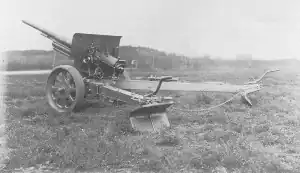10.5 cm cannon Model 1927
| 10.5 cm cannon Model 1927 | |
|---|---|
 | |
| Type | Heavy field gun |
| Place of origin | Sweden |
| Service history | |
| In service | 1927 – 1945 |
| Wars | World War II[1] |
| Production history | |
| Designer | Bofors |
| Designed | 1927 1931 |
| Manufacturer | Bofors[1] |
| Produced | 1927 – 1940s |
| Specifications | |
| Mass | 3,650 kg (8,046.87 lb) |
| Barrel length |
|
| Crew | 9[1] |
| Shell | 105×567mmR |
| Shell weight | 16 kg (35.27 lb) |
| Caliber | 105 mm (4.13 in) |
| Breech | Interrupted screw |
| Recoil | Hydropneumatic |
| Carriage | Split trail |
| Elevation | -3° / +45° |
| Traverse | 60°[1] |
| Rate of fire | 6–8 rounds/min |
| Muzzle velocity | 750 m/s (2,460 ft/s) |
| Maximum firing range | 16.5 km (18,000 yd)[1] |
The 10.5 cm cannon Model 1927 was a heavy field gun used by the Netherlands and Hungary during World War II.
History
Four were bought by the Swedish Coastal Artillery as 10.5 cm kanon m/27s. They were later upgraded to m/34 standard as m/27-34s. They were transferred to the field artillery in 1942.
Dutch guns were known as Stuk van 10-veld. The Dutch appear to have bought guns with both 40 and 42 caliber barrel lengths. Captured weapons were designated by the Wehrmacht as the 10.5 cm Kanone 335(h).
Hungary purchased a license and built them as 31 Ms.
Design
The gun was designed for motor traction with spoked steel wheels with rubber rims. The spades were removed and placed onto the trail legs for transport.
Users
References
- Citations
- Sources
- Chamberlain, Peter; Gander, Terry (1975). Light and medium field artillery. New York: Arco. ISBN 978-0-668-03820-1. OCLC 2067331.
- Gander, Terry and Chamberlain, Weapons of the Third Reich: An Encyclopedic Survey of All Small Arms, Artillery and Special Weapons of the German Land Forces 1939-1945. New York: Doubleday, 1979 ISBN 0-385-15090-3
- Secondary sources
- "31M TÁBORI ÁGYÚ". quartermastersection.com. Quartermaster Section.
- "STUK 10 VELD". quartermastersection.com. Quartermaster Section.